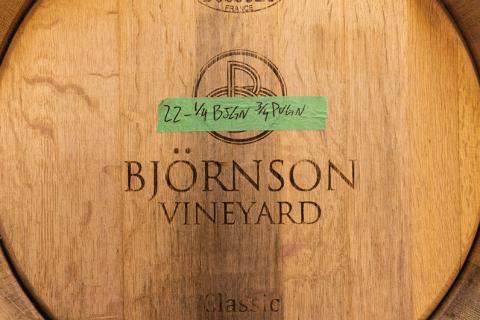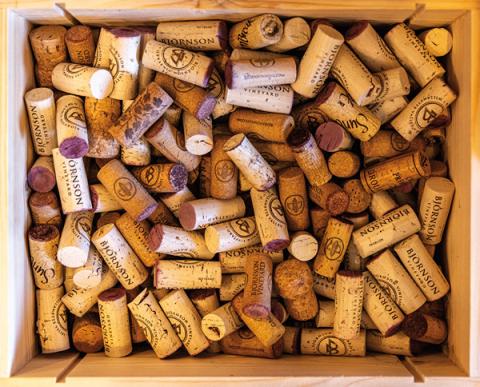
Winery with Carlson School Roots Makes History
Friday, October 13, 2023
By Steve Henneberry
A Carlson School alumni couple runs a history-making vineyard and winery in Oregon.
Björnson Vineyard, a 107-acre property, is nestled in the Eola-Amity Hills near Salem, Oregon.
It features two distinct areas: a 28-acre vineyard and winery is situated to the east and south; forest, creek, and wetland—including a 20-foot waterfall—make up the north and west. Mark Björnson, ’86 BSB, ’92 MBA, often walks along an old logging trail next to King’s Creek, absorbing the land’s history via moss-covered rocks, Douglas Fir trees, and dozens of native plants. While checking on the cedar trees he planted to diversify the forest, Mark stops when he notices lemon balm on the trailside. He has no idea how it got here.
Given the fertile soil in this part of the state, it’s no surprise things like to grow. Oregon’s Willamette Valley is one of the most productive agricultural lands in North America. It took shape over millennia. About 15 million years ago, vast lava flows created the volcanic soils that now comprise Björnson Vineyard. Relatively recently, about 15,000 years ago, the Missoula (Montana) Floods contributed the sedimentary soils at lower elevations in the valley. Experts at Western Oregon University say that roughly 40 times during a 2,500-year period, an ice dam on glacial Lake Missoula ruptured, sending water rushing down the Columbia River. The Willamette Valley flooded each time, leaving behind volcanic and glacial soils that, combined with an ideal climate, allowed crops to flourish on the valley floor.
Today, this history is underground, but not forgotten: It resurfaces in hazelnuts, Christmas trees, nursery plants, and many more crops. Mark and his wife, Pattie Björnson (née Knight), ’86 BSB, say their grapevines, the roots of which extend down 20 to 25 feet, pull water from the fractured bedrock beneath the rich volcanic soil. At the Björnsons’ second vineyard, Pamar, Mark recently found granite and gneiss rocks, brought in on ice floes by those floods, on the lower parts of the vineyard.
For the Björnsons, respecting the history of their land and sustaining it are priorities. They are certified Salmon-Safe and sustainable by Low Input Viticulture and Enology (L.I.V.E.). They use solar power and electric vehicles. They practice sustainable farming across more than 50 acres of plantings. These actions, and more, live out the first part of the Björnsons tripartite mission statement: “Care for the land.”
The last two parts are: “make exceptional wine” and “enjoy the journey.” The Björnsons are doing that, too. Married for 34 years, they’ve worked side by side running a vineyard and winery business for nearly two decades.
Care for the land, make exceptional wine, and enjoy the journey.
Carlson School Meet Cute
In 1985, as a new member of Delta Sigma Pi, the co-ed business fraternity, Pattie Knight had to interview active members. Up first: Mark Björnson. Born and raised in Bismarck, N.Dak., Mark came to UMN Twin Cities for the “warm weather” and to study business. “The last two questions were [about] short-range goals and long-range goals,” explains Pattie, who hails from Owatonna, Minn., and has familial roots in the state stretching back seven generations. “He didn’t know what his short-term goals were, but long-term, he said he wanted to live out in the country. He wanted to have a big garden. He wanted to build his own house. . . He wanted to have a large family. I just sarcastically answered, ‘Wow, look me up when you want to get married!’”
A few months later, they were dating. When they married in 1989, Mark’s job with Prudential prevented an immediate honeymoon. It wasn’t until September 1993, after Pattie was an established programming consultant, that they took a life-changing trip: riding a tandem bicycle rigged with a middle seat for their then-two-year-old daughter, Kaitlyn, 1,500 miles around Europe. Renting rooms at small wineries clarified their future dreams, swapping orchards and hobby farms for vineyards and wine.
The Oregon Trail
The location for this future operation was always Oregon, a place Mark often visited as a child, experiencing its stunning coastline, mountains, and rolling hills.
In the 1990s and early 2000s, the Björnsons focused on their corporate careers while raising four children in Minnetonka. But, the vineyard was never far from their minds. On a drive home in 2000, Pattie remembers telling Mark, “You have got to quit telling people that we’re going to move to Oregon, buy land, and plant a vineyard. Everybody thinks you’re crazy.” Mark’s immediate reply: “Well, I don’t care what they think.”
By 2005, Mark was president of the west region for United Health Group’s Medicare Advantage product and the family of six moved to Portland. The hunt for land, and knowledge, was on.
Planning and Planting
What the Björnson dream had in optimism, it lacked in understanding of what it takes to run a successful vineyard, so they added to their business education and experience by enrolling in the Wine Studies program at Chemeketa Community College in Salem. There, they learned about viticulture, farming, winemaking, and more while gaining hands-on experience in the school’s working vineyard.
During their studies, they made friends with fellow winemakers and found land “that checked all the boxes.” The old timber farm property had potential for a vineyard with four soil types and elevations ranging from 440 to 560 feet. It also offered a stunning view of Mount Hood and Mount Jefferson in the Cascade Range with the hills of Oregon wine country stretching out in the foreground.
After removing hundreds of trees and at least 1,000 tons of rock, planting began in Fall 2006 and now covers four blocks, each named for one of their children. The vines grow pinot noir, chardonnay, auxerrois, and gamay noir grape varieties.
“We didn’t quite realize—I’m not sure anybody really knew—just how great this property would be for producing tremendous grapes and wine,” admits Mark now.
Building a Business
Not everyone could consider starting a vineyard and winery as a side hustle—they describe it as “all-consuming”—but that’s how the Björnsons did it. “The most important point is to keep the day job,” says Pattie. “It’s very capital intensive,” adds Mark, who only last year left his full-time role at Catholic Health Initiatives.
With support from Pattie’s parents to help with their children, the Björnsons built a three-part business: growing grapes (agriculture), making wine (manufacturing), and selling both (retail). The business school fundamentals they learned played a key role. “We [do] a lot of short-term planning and long-term planning and budgeting,” Pattie says, who spent three years learning winemaking from Ben Casteel at nearby Bethel Heights Winery.
The pair describe working together, sarcastically, as being a “seamless team” that “always gets along beautifully.” More seriously, they’re aware of their strengths and weaknesses. Mark is the farmer and vineyard manager, and is especially busy during the fall harvest. That’s when Pattie’s job as winemaker picks up. She’s also serving as CEO. “They complement each other really well,” says Nancy Morrow, general manager of Björnson Vineyard. “They’re kind, respectful, good listeners, and will help you problem-solve. It’s a family here [for staff ].”
That vibe extends to the many vineyards across the Willamette Valley, a community the Björnsons say welcomed them with open arms, is very collaborative, and believes that a “rising tide lifts all boats.” Both Mark and Pattie now serve as volunteer leaders in nonprofit organizations supporting the region.
Making History
The Björnsons share a deep appreciation for roots, both familial and grape. Their winery is full of reminders, including a wall in the tasting room featuring 29 black-and-white photos of more than 50 relatives going back five generations. Each variety of pinot noir is named after an ancestor (such as Art, Isabel, Magnus). And every bottle label features an artwork called Fire and Ice, meant to represent “their Icelandic heritage as well as the magnificent volcanic and glacial forces that created our soils.”
They can also hold a lengthy discussion on grape genealogy. So, it’s only natural that the Björnsons now have the only commercial planting in the western hemisphere of a rare, historically significant grape that has wine geeks and industry folks turning up to give it a taste. The gouais (pronounced “goo-aay”) blanc is the parent of a whopping 81 different grape varieties, including chardonnay, riesling, and aligoté, among many others.
Widely planted in the Middle Ages in Germany and France, gouais blanc was almost extinct. The French believed it produced inferior wine and banned it in the 1700s. “It was the wine of the peasants,” says Mark. But scientists at the University of California, Davis doing DNA testing on common varieties today, discovered its important genetic contributions. “In France, when they found that gouais blanc was a parent of chardonnay, it went over like a bad paternity test,” says Mark, who received a few cuttings of the vines for himself.
The half acre is planted at Pamar Vineyard, a property the Björnsons bought in 2013 located in the Van Duzer Corridor, 20 minutes west. The lower elevation allows gouais blanc, and several other boutique varieties, to grow well. “It’s easy to see why the peasants liked it so well—it had these great big clusters [of grapes],” says Mark.
The Björnsons describe the taste as “very crisp and citrusy,” adding it’s “the perfect oyster wine,” and “a great wine for acid lovers.”
With deep roots in place, Mark and Pattie are living out each part of their mission statement. No matter what the future holds, you can raise a glass to that.





